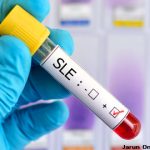Recently, belimumab, a monoclonal antibody that targets the cytokine BLyS, was the first new drug in the last 50 years to be approved by the U.S. Food and Drug Administration for the treatment of systemic lupus erythematosus (SLE). The relative lack of new therapies for SLE indicates how little we understand about this difficult disease. SLE is a disease characterized by production of autoantibodies, some of which mediate disease pathogenesis. Yet, in clinical trials rituximab, a B cell–depleting therapy, did not clearly show benefits anticipated for this approach. Even with belimumab, the effects of this agent in patients with more severe manifestations of lupus are unknown at this time because the clinical trials did not include patients with active nephritis or central nervous system disease.
Other attempts to target specific components of the immune system have been limited by the complexity of this disease, and therapy for the most part remains broad-based immunosuppression. The use of agents with broad activity is not necessarily inappropriate, because patients with SLE display many abnormalities across all arms of the immune system. For example, dysregulation of the innate immune system is demonstrated by overactive interferon production and Toll-like receptor signaling in patients with SLE. Similarly, adaptive immune abnormalities include autoantibody production and defective T-cell killing.
Our journey into the role of T cells in SLE pathogenesis began many years ago with the initial observation that SLE T cells express less interleukin (IL)-2. IL-2 is a key cytokine for T-cell activation, proliferation, and differentiation. Why SLE T cells make less IL-2, and what this means for T-cell function in lupus, has driven our group’s work for the past 20 years. This review will focus on the many T-cell abnormalities that have been described by our group and others in patients with SLE. These findings can be roughly divided into two categories: abnormal T-cell signaling responses and abnormal T-cell effector activity. Importantly, these disturbances provide opportunities for the development of new targets for therapy and biomarkers for disease activity.
The Normal T Cell
The T cell is a critical component of the adaptive immune system and provides multiple functions. T-cell activation begins with the T-cell receptor (TCR), which recognizes foreign peptides on the surface of antigen presenting cells (APCs). This is quite a nuanced response, because the TCR must also be able to recognize and ignore self-antigen that is presented on the same APCs. The activated T cell is then capable of a number of functions, including cell-mediated killing of the APC, activation and recruitment of other inflammatory cells, and modulating the antigen-specific B-cell response. The normal T cell, therefore, is the center of a sophisticated response to immune challenge, including infection and immunization. As research into T-cell differentiation has progressed over the years, it has become apparent that there are several, if not many, subsets of T cells that serve different functions.
